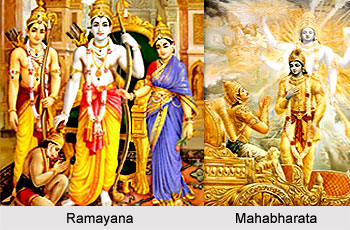 Hindi theatre is regarded as the continuity of Sanskrit theatre. Hindi found its expression in varied theatrical narratives like Ramlila (in the Avadhi tongue), Raslila (in Brajbhasha), Bhagat, Nautanki/Sangit/Swang, and Naqal (all in Haryanvi or Khariboli mixed with Brajbhasha), Bidesiya (Bhojpuri), Mach (Malvi), Nacha and Pandavani (Chhattisgarhi), Khyal (Rajasthani), and Karyala (Himachali mixed with Khariboli).the natyas are an important part of the Hindi Theatre.
Hindi theatre is regarded as the continuity of Sanskrit theatre. Hindi found its expression in varied theatrical narratives like Ramlila (in the Avadhi tongue), Raslila (in Brajbhasha), Bhagat, Nautanki/Sangit/Swang, and Naqal (all in Haryanvi or Khariboli mixed with Brajbhasha), Bidesiya (Bhojpuri), Mach (Malvi), Nacha and Pandavani (Chhattisgarhi), Khyal (Rajasthani), and Karyala (Himachali mixed with Khariboli).the natyas are an important part of the Hindi Theatre.
The natyas (theatres) in Hindi Theatres included many elements from Sanskrit dramaturgy like incorporation of rasa, sources for themes and stories from Mahabharata, Ramayana, and Bhagavata Purana. These also include theatrical approaches, conventions, and practices like the purvaranga (preliminaries), kakshya vibhaga (stage zones or locales), and treatment of time and space. Different roles like that of the sutradhara (director-manager) and vidushaka (jester) are also important. As these natyas employed the common people`s spoken or literary idiom, theatre ceased to be an elite preserve and acquired wide popular patronage. It came out of the royal courts and their mandapas (halls) and began to be staged in village squares or fields, town marketplaces, temple grounds, or other suitable outdoor locations, before large audiences. Each natya has its definite character in its choice of themes, quantum and use of speech, staging methods, music, and dance, style of presentation or nature of performance space.
There are certain differences in Hindi Theatre. First, unlike Sanskrit Theatre, most of them do not have literary drama or scripts. Rather they use memorized or written synopses taken from mythological or historical episodes, legends, and tales. These are written by the performers with the help of poetry, song, dance, and mime. Secondly few of the plays are based on Ramlila, Raslila, and Bhagat that are inspired by or closely related to the Bhakti religious movement that was prevalent in India during the fourteenth to seventeenth centuries. Later in the eighteenth and nineteenth centuries, many others like the Nautanki, Swang, Bidesiya, Mach, Nacha, Xaqal, Karyala came into being. These were based on secular themes.
Even the devotional theatres which were dominated by ritualistic, spiritual content and tone had the feel of contemporary social reality.
While staging the plays these natyas employing the actor- or singer provide not only flesh and blood to the narrative frame conceived by the producer, but also instils it with liveliness and meaning. It is for this reason that the natyas adopted the sutradhara and vidushaka for executing important functions. The role of sutradhar is to now select stories and prepares its scenario from existing versions. He also uses narrative or lyrical poetry and song available in the dialect. He also instructs the actors in singing, dancing, and miming. He is responsible of controlling the rhythm of the performance on the stage, singing or narrating most of the songs, linking the action, and, also playing minor roles. He thus plays the role of a dramatist as well as a director. The vidushaka, on the other hand, provides humour and wit in the plays and at times also does commentary. He also plays the role of relating distant mythological situations or characters to contemporary life.
These theatres also infuse music and dance with words as a mode of communication, enriching the performances aesthetically, making them imaginative, absorbing, multi-level experiences.
Development of Solo Performance
Solo performance is another element of Hindi Theatre that emerged on account of shortage of funds. It was evolved because actors did not have the time to work with a team. Solo performance could also be the result of actors making their presence felt to give an independent statement without any director`s interference. Solo performance has thus given the performers the liberty and space to further explore and extend their professional skills.
It can be said that earlier for staging theatres one had to depend by translations and adaptations of plays from the West and other Indian languages but today the directors themselves devise performance texts that rely on a variety of sources. For example Mohan Singh Maharishi used Einstein`s life and the theory of relativity; Kirti Jain, interviews with Partition survivors; Anuradha Kapur, the autobiography of Gujarati female impersonator Jaishankar Sundari to examine gender representation; Anamika Haksar, the history of the Dramatic Performances Act and a Tamil epic. However the growth of Hindi theatre seems to be positive. It is a site where much experimentation in content and form takes place. There has been all round development even at the level of the visual language, space and design. With time Hindi theatre has also become innovative in the fields of scenography, designing and also in involving new thoughts and generating new media.




